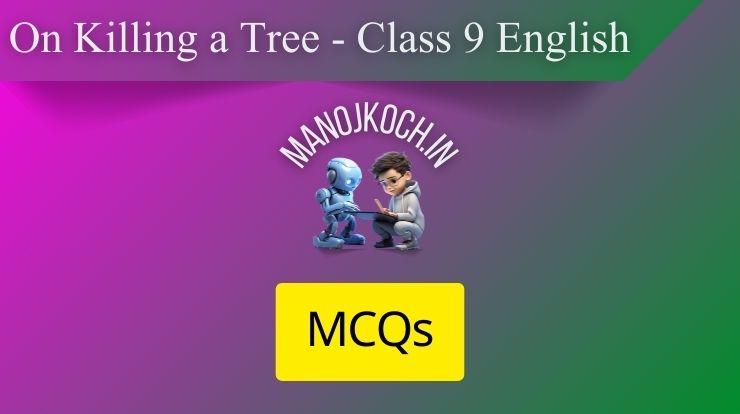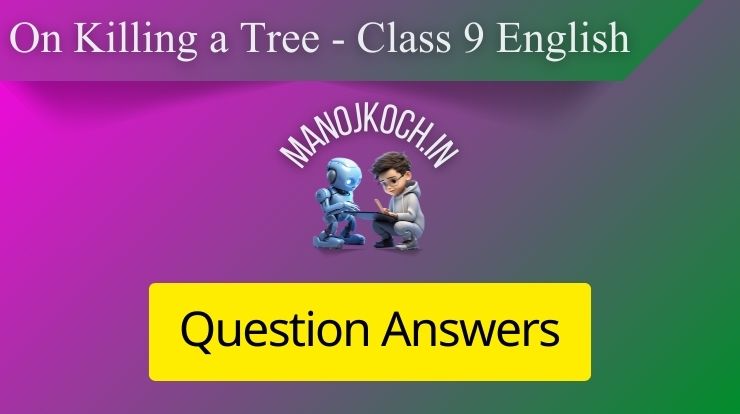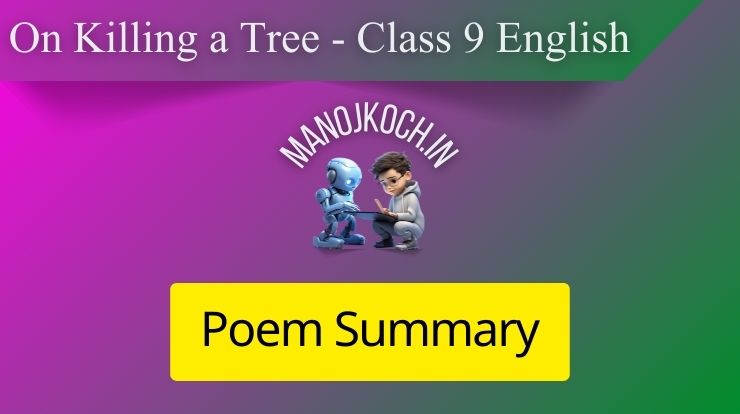On Killing a Tree
Table of Contents

On Killing a Tree Question Answers | MCQs
1. What is needed to kill a tree according to the poem?
- (a) A simple jab of a knife
- (b) Cutting the leaves
- (c) Pulling it out by the roots
- (d) Trimming its branches
Answer: (c) Pulling it out by the roots
2. What does the phrase “bleeding bark” suggest in the poem?
- (a) The tree is dead
- (b) The tree is injured and leaking sap
- (c) The tree is growing new leaves
- (d) The tree is immune to pain
Answer: (b) The tree is injured and leaking sap
3. Why can’t a tree be killed with a “simple jab of the knife”?
- (a) The knife isn’t sharp enough
- (b) The tree is too strong and deep-rooted
- (c) The tree is protected by its bark
- (d) The knife only removes a few leaves
Answer: (b) The tree is too strong and deep-rooted
4. In the poem, what happens after the tree’s roots are pulled out?
- (a) The tree begins to die
- (b) The tree grows back stronger
- (c) The roots replant themselves
- (d) The tree remains healthy
Answer: (a) The tree begins to die
5. Which of the following words is not used to describe the tree’s life and activity?
- (a) Consuming
- (b) Growing
- (c) Feeding
- (d) Shrinking
Answer: (d) Shrinking
6. What does “anchoring earth” refer to?
- (a) The place where the roots are buried
- (b) The leaves of the tree
- (c) The trunk of the tree
- (d) The surrounding forest
Answer: (a) The place where the roots are buried
7. According to the poet, how does the tree “absorb”?
- (a) By using its leaves
- (b) Through air and sunlight
- (c) Through water and nutrients from the soil
- (d) By growing toward the sun
Answer: (c) Through water and nutrients from the soil
8. What phrase describes the strength of the tree’s roots in the poem?
- (a) “Strong roots”
- (b) “Anchoring earth”
- (c) “Deep and powerful”
- (d) “Exposed strength”
Answer: (b) “Anchoring earth”
9. Which element does not contribute to the death of the tree?
- (a) Sunlight
- (b) Rain
- (c) Air
- (d) Removal of roots
Answer: (b) Rain
10. In the third stanza, what does the poet mean by saying “No”?
- (a) A tree cannot be killed by superficial means
- (b) The tree will continue to grow
- (c) The tree has grown too old
- (d) The tree needs sunlight
Answer: (a) A tree cannot be killed by superficial means
12. What ultimately happens when the roots of the tree are exposed?
- (a) They strengthen
- (b) They get sunburned
- (c) They dry out and wither
- (d) They produce new saplings
Answer: (c) They dry out and wither
13. What does the poet suggest about the tree’s life force?
- (a) It is weak and fragile
- (b) It is deeply rooted and resilient
- (c) It grows faster in sunlight
- (d) It survives without roots
Answer: (b) It is deeply rooted and resilient
14. The line “the strength of the tree exposed” means:
- (a) The branches are strong
- (b) The roots, which give life to the tree, are revealed
- (c) The leaves turn green
- (d) The trunk is the strongest part
Answer: (b) The roots, which give life to the tree, are revealed
15. What is required to kill the tree according to the poet?
- (a) Patience and care
- (b) Strong winds
- (c) Complete uprooting and exposure to sun and air
- (d) Heavy rainfall
Answer: (c) Complete uprooting and exposure to sun and air
16. How does the poet depict the tree in the poem?
- (a) As fragile and easily damaged
- (b) As strong, resilient, and difficult to kill
- (c) As dependent on animals
- (d) As weak and brittle
Answer: (b) As strong, resilient, and difficult to kill

I. On Killing a Tree Question Answer:
- Can a “simple jab of the knife” kill a tree? Why not?
- No, a simple jab of the knife cannot kill a tree because it is deeply rooted and resilient. Cutting the surface or branches won’t destroy its life force.
- How has the tree grown to its full size? List the words suggestive of its life and activity.
- The tree has grown to its full size by absorbing sunlight, air, water, and nutrients from the soil over many years. Words like “consuming,” “rising,” “feeding,” and “sprouting” suggest its life and activity.
- What is the meaning of “bleeding bark”? What makes it bleed?
- “Bleeding bark” refers to the sap that oozes out when the bark of a tree is cut. It bleeds when its outer layers are wounded, similar to how blood comes out of a human body when injured.
- The poet says “No” in the beginning of the third stanza. What does he mean by this?
- By saying “No,” the poet emphasizes that simply cutting the branches or wounding the bark is not enough to kill a tree. It requires more drastic measures to destroy it completely.
- What is the meaning of “anchoring earth” and “earth cave”?
- “Anchoring earth” refers to the soil that holds the roots firmly in place, providing stability to the tree. “Earth cave” suggests the deep area in the ground where the roots are hidden and protected.
- What does he mean by “the strength of the tree exposed”?
- “The strength of the tree exposed” means that when the roots, the true source of the tree’s strength, are pulled out from the earth, the tree’s life force is revealed and becomes vulnerable.
- What finally kills the tree?
- The tree is finally killed when it is uprooted completely, exposing it to the sun and air, which eventually causes it to dry up, wither, and die.

On Killing a Tree Summary:
The poem “On Killing a Tree” by Gieve Patel explores the resilience and life force of a tree, emphasizing how deeply it is connected to the earth and the natural world. Patel describes how a tree cannot be killed by a simple cut or wound to its bark; instead, it survives such injuries and continues to grow. The poet explains that to truly kill a tree, one must uproot it entirely, exposing its roots, which are its source of life and strength. Only when the roots are pulled out from the “anchoring earth” and exposed to the harsh sun and air does the tree begin to dry, wither, and ultimately die.
The poem serves as a metaphor for human resilience and strength, suggesting that true destruction requires going to the very core of something. Patel’s tone is ironic and critical, subtly condemning the violence humans inflict on nature. Through this imagery, he reflects on the destruction of nature, the persistence of life, and the lengths required to disrupt that life force permanently.

On Killing a Tree Line by Line Explanation / Stanza Wise Explanation:
Stanza 1:
“It takes much time to kill a tree,
Not a simple jab of the knife
Will do it.”
The poem begins by emphasizing that killing a tree is not an easy task. A simple jab with a knife cannot destroy it, as the tree has deep roots that nourish and strengthen it. This suggests that nature’s resilience requires sustained effort to overcome.
“It has grown
Slowly consuming the earth,
Rising out of it, feeding
Upon its crust, absorbing
Years of sunlight, air, water,
And out of its leprous hide
Sprouting leaves.”
These lines describe the tree’s slow, steady growth, rooted deeply in the earth. The words “consuming the earth” and “feeding upon its crust” suggest the tree’s strong, symbiotic connection with the earth, from which it absorbs nutrients, water, sunlight, and air. This prolonged process makes the tree resilient. The “leprous hide” (rough bark) symbolizes the scars and textures the tree acquires over time, yet it still produces leaves, a sign of life and renewal.
Stanza 2:
“So hack and chop
But this alone won’t do it.”
Even if someone hacks or chops the tree, it is still not enough to kill it completely. The tree has an incredible ability to recover and continue growing because its roots remain deeply entrenched in the soil.
“Not so much pain will do it.
The bleeding bark will heal
And from close to the ground
Will rise curled green twigs,
Miniature boughs
Which if unchecked will expand again
To former size.”
The imagery of “bleeding bark” refers to the tree’s sap, which oozes when cut. The tree may seem hurt or damaged, but it can heal and regenerate from the remaining parts, symbolized by “curled green twigs” and “miniature boughs.” This resilience allows the tree to grow back if its roots are intact.
Stanza 3:
“No,
The root is to be pulled out –
Out of the anchoring earth;
It is to be roped, tied,
And pulled out – snapped out
Or pulled out entirely,
Out from the earth-cave,”
The poet emphasizes that to truly kill a tree, its roots must be pulled out from the soil. The phrase “anchoring earth” reflects the strength with which the roots are bound to the ground. This is not an easy process; it requires great force, as the roots hold firmly, like an anchor. The “earth-cave” symbolizes the place where the roots lie hidden, protected, and nurtured. The roots are essential for the tree’s survival, and removing them is the only way to ensure the tree’s death.
“And the strength of the tree exposed,
The source, white and wet,
The most sensitive, hidden
For years inside the earth.”
Once the roots are exposed, we see the tree’s hidden strength and vulnerability — “white and wet” indicates the freshly exposed roots, which are now susceptible to air and sunlight. This exposure symbolizes the tree’s vulnerability once its life source is uprooted.
Stanza 4:
“Then the matter
Of scorching and choking
In sun and air,
Browning, hardening,
Twisting, withering,
And then it is done.”
Once the tree is uprooted, it slowly starts to die, no longer able to absorb water and nutrients from the earth. The “scorching and choking” in the sun and air cause the roots to wither and die, symbolized by “browning,” “hardening,” and “twisting.” Finally, the tree dies, and its destruction is complete.
On killing a tree rhyming scheme:
“On Killing a Tree” by Gieve Patel does not follow a specific rhyme scheme. The poem is written in free verse, meaning it does not adhere to a regular meter or rhyme pattern. This structure is intentional and reflects the natural, raw theme of the poem, paralleling the irregular, untamed growth of a tree itself.
The lack of rhyme emphasizes the seriousness and realism of the poem’s subject: the challenging, deliberate act of killing a tree. By using free verse, Patel creates a conversational and almost instructional tone, which mirrors the poem’s step-by-step description of destroying a resilient life form. This poetic choice enhances the poem’s impact, making the description of the tree’s strength and eventual demise feel stark and unembellished.
What type of poem is on killing a tree?
“On Killing a Tree” by Gieve Patel is a lyric poem with elements of satire and didacticism. Here’s how these types apply to the poem:
- Lyric Poem: The poem captures the poet’s strong emotions about the act of destroying a tree. Through vivid imagery and personification, Patel expresses sorrow and critique towards the act of violence against nature.
- Satirical Elements: The poem uses a satirical tone to criticize human actions against nature. By providing a step-by-step guide to killing a tree, it indirectly mocks the cruelty and persistence required to destroy such a resilient life force.
- Didactic (Educational) Poem: The poem is didactic because it imparts a moral lesson about the resilience of nature and the cruelty involved in harming it. Patel suggests that uprooting trees is unnatural and morally questionable.
The poem’s free verse structure and straightforward language help convey these themes in a raw, unembellished way, making the reader think deeply about the relationship between humans and nature.
On Killing a Tree summary in 100 words:
“On Killing a Tree” by Gieve Patel is a powerful poem that addresses the resilience of nature and criticizes human cruelty toward it. The poem describes the arduous process of killing a tree, emphasizing that simply cutting it will not suffice, as a tree’s roots are deeply anchored in the earth, drawing sustenance and strength. The poem portrays the tree as a living entity with “bleeding bark” and a tenacious will to survive. Only by uprooting it completely can the tree be killed, symbolizing the destructive persistence humans show in harming nature. Through this, Patel calls for respect toward nature’s vitality.
On Killing a Tree central idea:
The central idea of “On Killing a Tree” by Gieve Patel revolves around the resilience of nature and the destructive tendencies of humans. The poem illustrates that a tree cannot be easily killed; it takes deliberate, forceful uprooting to destroy it completely. This struggle symbolizes the enduring power of nature, which, despite harm, continues to survive and regenerate. Patel’s work also critiques humanity’s relentless exploitation of nature, highlighting the violent measures taken to suppress its resilience. Ultimately, the poem encourages readers to respect and value nature’s strength and life-giving qualities rather than seek to dominate it.
Theme of the Poem on Killing a Tree:
The theme of “On Killing a Tree” by Gieve Patel centers on the resilience of nature and the destructive impulse in humans. The poem explores how deeply rooted trees, symbolizing the endurance and vitality of nature, cannot be killed by a mere act of superficial violence. Nature resists destruction, regrowing and healing itself even when harmed. The poem also underscores humanity’s invasive and forceful approach to conquering nature, reflecting the disregard for its intrinsic strength and vitality. Through vivid imagery, Patel invites readers to reflect on the relationship between humans and nature, emphasizing respect for the natural world rather than exploitation.
3 thoughts on “On Killing a Tree Question Answers | Assamese Medium”